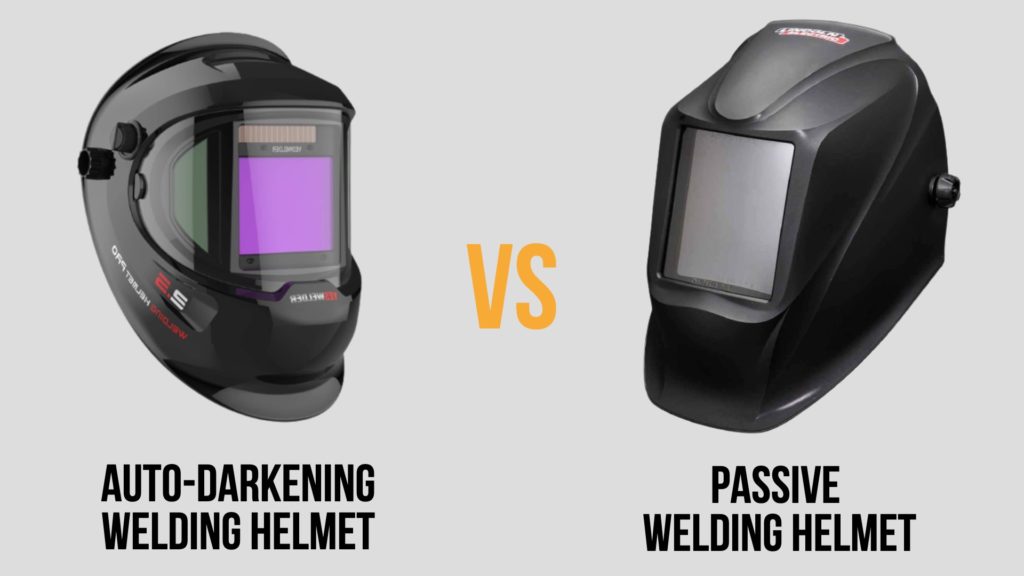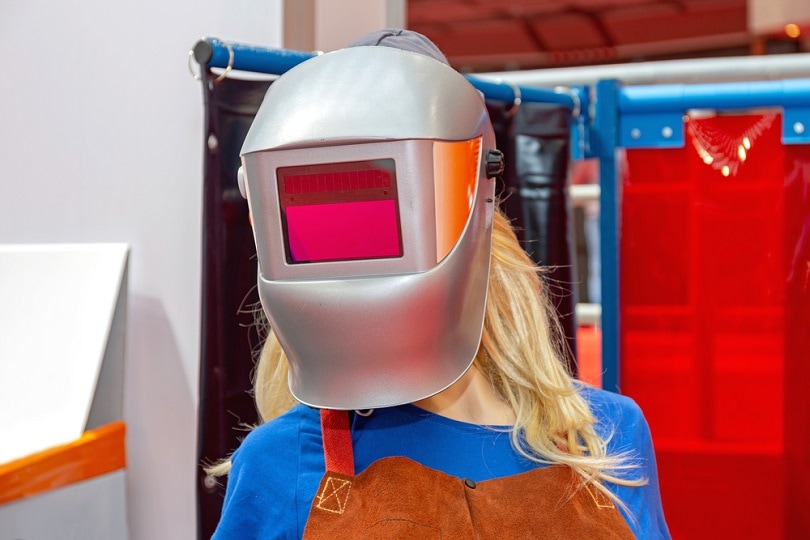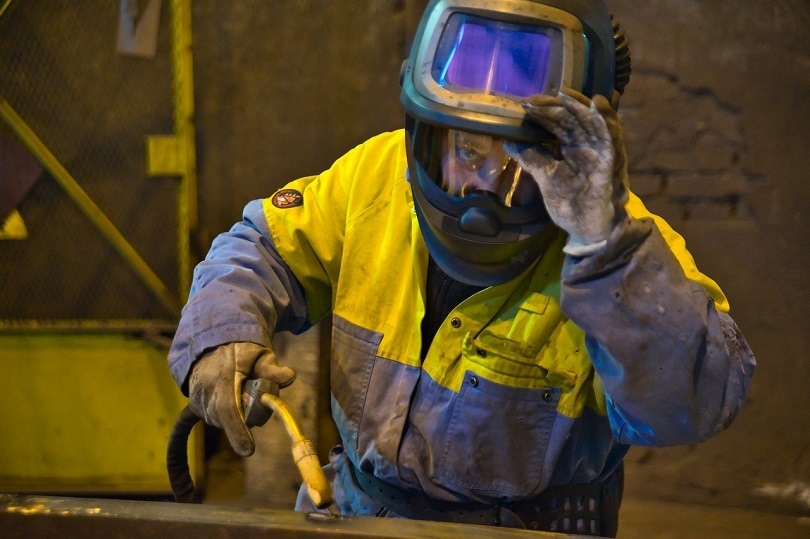Auto-Darkening vs. Passive Welding Helmet: Which Is Better?
Last Updated on

For a welder, wearing safety gear is imperative. A helmet is the most crucial welding equipment because it protects the eyes from direct contact with fire sparks when the arc is struck. Therefore, it protects one from the risk of eye-related medical issues such as arc eye and retina burns. Apart from the eyes, helmets cover the entire face and the neck, too.
If you are in a dilemma on the type of helmet to use, this article contains all you need to know concerning the two. Remember, it goes without saying that both auto-darkening and passive welding helmets meet all the National Safety Standards requirements.
Your choice of the best welding helmet will largely depend on their distinct features, advantages, disadvantages, how they work, and the lenses’ quality.
Auto-Darkening Welding Helmets Overview

Before delving deep into the matter, let us take a trip down memory and recall what life was like before auto-darkening helmets were invented.
About 15 years ago, welders were practically groping in the dark when striking the arc for the first time. In those days, once the welding mask was on, you could not see anything until the arc was struck. It was common to miss the actual point to start working on since the lenses were very dark. The lenses had to remain dark because the sparks and bright light are very damaging to the eyes.
The hallmark of the auto-darkening welding helmet is its accuracy. After setting and wearing it, the glass automatically darkens within milliseconds of the arc being struck when you start welding. This means that you can see out of the helmet before you begin welding. When you look through the lens, you can see everything you normally would, except there is a little bit of a greenish tint. Nevertheless, you can see everything clearly before and after wearing the helmet.
Auto-darkening welding helmets have unique features such as an auto-darkening filter lens, multiple arc sensors, and the battery pack. The sensors are on the helmet’s side ridges, with most helmets having between 3 and 6 arc sensors—the more the sensors, the better the coverage.
How Do Auto-Darkening Helmets Work?
As the name suggests, auto-darkening welding helmets use an auto-adjusting technique, which allows the lens to automatically adjust from light to dark upon detection of light emissions from a welding machine. The lens has a sensor that detects light with filters and cells present in the viewing plane.
Auto-darkening helmets are powered using batteries or solar energy. The sensors will detect the arc because it produces light that triggers the sensor to transmit a signal responsible for the liquid crystals (darkens and lightens according to light intensity) activation, which darkens the lens to the predetermined shade level.
An auto-darkening helmet also has an infrared and polarization filter, which keeps your eyes off radiations even when the automatic darkening isn’t activated. Inside the helmet are controls that expound on its functionality.
Delay time: sets how fast it will go dark.
- Auto-darkening lens
- Better eye protection
- Adjustable delay time
- Works even without activating the auto-darkening
- More comfortable positioning since welders don’t take it on and off
- Enhance productivity since welders can work faster
- Protects the face and neck too
- Guaranteed maximum eye protection
- Perfect for working in tighter spaces
- Allows better control of the torch
- Must be powered by batteries, solar, or both
- Heavier due to the extra parts
- Repairs and part replacements are expensive
- View darkens with the first arc spark
- Costly
Passive Welding Helmet Overview

For several decades, passive welding helmets were the only choice for welders. Today, millions of welders still prefer to use this type of helmet because of its simplicity. In fact, you’ll notice that more experienced welders are still comfortable with it.
Passive welding helmets have a standard lens with a fixed shade of #10 coated with UV and IF protection to shield the welders’ eyes (from arc and glare), neck and face. These helmets can either be handheld or worn on the forehead. Also, when welding, you have to take off the helmet and inspect the welds. They will never die or fail you since they do not need batteries.
Besides, since they do not have glass lenses, they won’t flash on you as you weld. Another feature that stands out in these types of welding helmets is their clarity. If you put the right lens, like a gold glass lens, the clarity you achieve almost feels like welding in HD. These helmets are so resilient.
However, they have a downside. They are much harder to use, especially for SMAW or stick welding purposes. You have to keep positioning yourself and flipping the helmet, but it’s a technique you get used to with time. Another challenge is that the filter offers the same protection level regardless of the quantity of amps emanating from the light during welding.
Due to its convenience, you need to have one, at least as a backup, if you don’t want to use it frequently.
How Do Passive Welding Helmets Work
Using a passive welding helmet is equally simple because it does not have extra features. The lens is an essential part of the helmet, and you can replace the shades. These shades have a UV and IR protection coating that shield your eyes from the arc.
Passive welding helmets also have a shell that protects your face during welding and a strap to hold the helmet on your head. Alternatively, you can choose to hold the helmet with your hands instead of wearing it on your head, depending on the nature of the job you are doing.
- Affordable
- Lightweight
- Ample face and head protection
- UV and IR protection
- Easier to repair
- Magnificent optical clarity
- Replaceable lens
- No power source needed
- Easier to operate
- Limited adjustments
- Has only one shade (#10)
- Manual positioning only
- Lack electronics
- Not beginner-friendly
Auto-Darkening vs. Passive Welding Helmet
The main difference between the two helmets is in the lenses. In the auto-darkening helmet, the lenses become dark immediately you start the torch. When the machine helmet is not in use, the lens becomes clearer. A passive welding helmet, on the other hand, does not change colors.
When comparing auto-darkening and passive welding helmets, the parameters will help you determine your helmet of choice. The table below summarizes the differences.
| Auto-Darkening Welding Helmet | Passive Welding Helmet | |
| Affordability | Expensive because of extra features (e.g. ADF knob, arc sensors, sensitivity filters, shade, lens, battery, helmet shell) |
Less expensive because it has fewer features |
| Operation | Electronic and manual | Manual |
| Weight | Heavier | Lightweight |
| Repairs and replacements | Expensive and time-consuming | Quick and cheaper |
| Size | Most are bigger | Most are smaller |
| Safety | Protects eyes, neck, face | Protects eyes, neck, face |
| Shades | #8, #9,#10,#11,#12,#13 | #10 |
| Sensors | 3 to 6 | No sensors |
| Maneuverability | Easier to maneuver because it works perfectly in tighter spaces | Harder to maneuver because a welder has to flip the helmet up and down |
| Visibility | Constant | Inconsistent |
1. Cost
Protecting your eyes, face, and neck should always be a priority. Before purchasing a welding helmet, you can conduct a market feasibility study to ensure you get the best deal. Visiting online stores and local hardware are great areas to start from.
Auto-darkening helmets will cost you more compared to the passive ones. The price disparity is obviously due to their distinct features, like convenience. A tight budget does not necessarily mean you settle for less. While the auto-darkening helmets are more costly, they have different price ranges depending on the features fitted. However, generally, the passive ones are always more affordable.
2. Purpose
While all these helmets’ main aim is to protect you while getting the job done, sometimes the need to use one override the other, as we had explained earlier in the overview sections.
3. Power Source
Auto-darkening welding helmets require a battery or solar power to function correctly. Consider where you’re going to get the power from, i.e., where you will purchase the batteries and their cost or where you will charge your solar-powered helmet, is there enough sunlight to charge the battery pack fully?
4. Safety Standards
All welding helmets should comply with internationally recognized safety standards. Helmets mainly protect our eyes from the harmful light produced during welding. Both auto-darkening and passive welding helmets meet the required standards.
In the United States, welding helmets should adhere to the industry-standard ANSI Z87.1. All helmet manufacturers must comply with these safety standards to keep all welders safe and avoid potential lawsuits.
The requirements for welding in a specific workspace is the responsibility of The Occupational Safety and Health Administration (OSHA). You have to ensure that the helmet you are purchasing comply with all the OSHA requirements.
Frequently Asked Questions
What is a weld shade number?
Weld shade number refers to a welding helmet’s capability to provide 100% protection of your eyes from UV and IR within a temperature range of 23 to 77 degrees Fahrenheit. These shades vary from 8 – 13, with 10 being the standard range used in passive welding helmets.
How long can a welding helmet last?
Welding helmets do not have a standard lifespan. Its usefulness is wholly dependent on the welder. Factors that determine how long a welding helmet lasts depend on how it is stored, the type of batteries used, the environmental conditions the helmet is exposed to, and how well the welder handles it.
Choose glass or plastic shades?
Auto-darkening welding helmets are available in plastic and glass lens options. Glass shades are better because plastic can distort the light and color profile. Alternatively, if you are working on a tight budget, a plastic shade should be a perfect choice since they are less expensive.
Which Is Better?
At this point, most people would wish to see a one-way verdict. However, experts will tell you the decision depends on your needs.
As a beginner, an auto-darkening helmet is a perfect choice since it almost operates on autopilot. This means you can pre-set most features and work uninterruptedly. Whichever one you choose, ensure you can handle both. For instance, if you go for the auto-darkening one, consider being comfortable with the passive hood too. That way, in case your favorite choice gives up on you at a crucial hour, the latter will be your saving grace.
As a business-savvy person, you’ll mostly settle for a time-saving gadget since it improves your productivity and cuts on downtime. However, some experienced welders prefer passive welding helmets because of their clarity.
After considering all factors between auto-darkening and passive welding helmets, the best you can do is to wear and test each and settle for what works for you. If you are comfortable with it and can see through it clearly, arrange to make the purchase.
